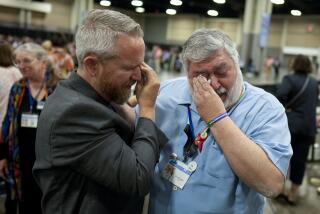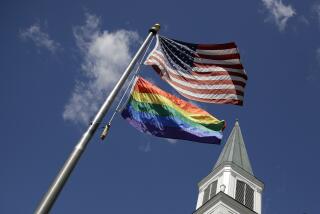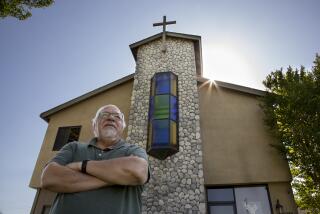3 Lutheran Churches to Merge Into 4th Largest in Protestantism
- Share via
MILWAUKEE — Lutherans meeting here and in two other cities Friday overwhelmingly approved plans to merge into one denomination, which will make it the fourth largest in U.S. Protestantism.
The new 5.3-million member Evangelical Lutheran Church in America, when inaugurated in 1988, will be exceeded in membership only by Southern Baptists, United Methodists and National Baptists.
The union, four years in the making, was hailed by presiding bishops of the three uniting churches as a significant step for the larger cause of Christian unity and for a strong Lutheran voice in national affairs.
In the decisive votes Friday, the 2.9-million-member Lutheran Church in America (LCA), convening here, approved the merger 640 to 29; the 2.3-million-member American Lutheran Church (ALC), meeting in Minneapolis, favored the union 891 to 59 with one abstention, and the 110,000-member Assn. of Evangelical Lutheran Churches (AELC), in Chicago, gave it unanimous approval, 137 to 0.
Includes All Spectrums
Referring to the European language and ethnic divisions characteristic of most Lutheran churches in the past, Presiding Bishop David Preus of the ALC said: “We are now all melded into an American church. . . . It’s a church cutting across all the spectrum of people.”
For the ALC’s approval to be complete, two-thirds of its nearly 5,000 congregations must ratify the merger in voting over the next six months. Preus expressed confidence that they would affirm the convention’s decision.
LCA Presiding Bishop James R. Crumley, in a tri-city news conference with the other bishops, said that while the new church “will be more powerful” speaking with one voice instead of three, “the unity of the church” was the primary motive for merging.
AELC Bishop Will Herzfeld of Oakland concurred, saying the potentially increased influence on political and social issues is “simply one of the byproducts of merger.”
Phone Hookup Fails
Plans to announce the results simultaneously to the assembled delegates via a telephone hookup failed. During a lull in the wait for connections to be made, defrocked LCA Minister Daniel N. Solberg walked up to the podium microphone here to denounce the merger, beginning: “Thus says the Lord, I hate your adulterous merger, your whoring after corporate idols . . . your congregations will wither and your people fall away.”
The sound was turned off, delegates started clapping rhythmically to drown out Solberg and the session was adjourned. Police officers later removed Solberg from the building.
Solberg, of Allison Park, Pa., was dropped from ministerial rolls last June for disobeying church regulations and his bishop. Solberg and W. Douglas Roth, who was defrocked a year earlier for similar reasons but who was present here, charged that church officials were derelict in helping the unemployed.
Little Suspense
The disruption was an unexpected climax to a convention where the only suspense had been over the choice of a headquarters city.
The new denomination was shaped essentially by a 70-member joint commission of bishops, clergy and lay people.
It fashioned a quota system whereby every national committee and convention of the church will have at least 10% of its members from minority groups. In addition, half of the boards will be lay people and 50% of those must be women. Though some LCA officials objected to precise ratios at first, the formulas were passed by considerable margins here earlier this week.
In seeking a suitable headquarters in the Midwest, where most Lutherans live, the joint commission last February reached an impasse over the top choices, Minneapolis and Chicago, and surprised most Lutherans by picking Milwaukee.
Milwaukee Choice Opposed
But before the commission’s final meeting in June, Milwaukee was opposed by many church leaders--especially in the LCA--as a less-than-world-class city difficult to reach by air travel. The commission changed its mind and chose Chicago.
When the LCA came here for its biennial convention this week, delegates were besieged with appeals by Milwaukee boosters, from bags of chocolates left at their hotel rooms to a newspaper editorial extolling the lakeside city’s economical advantages and clean look.
The ALC convention voted for Milwaukee by a 2-1 margin, but the LCA and AELC both backed the commission’s final choice of Chicago, described by one LCA delegate as “the theological capital of American Christianity” because of its large cluster of seminaries and divinity schools. The commission’s choice of Chicago thus stood.
Quota Precedent Seen
The Evangelical Lutheran Church in America will not be the first denomination to use a quota system to assure minority and female representation in its decision-making assemblies and boards. Similar guidelines have been employed by the United Church of Christ and the United Methodist Church.
But the merging churches have relatively few minority members--only 2%. The three conventions appeared to accept the argument of the joint commission that quotas could spur increased minority participation and membership.
A former LCA president, Robert Marshall of Columbia, S.C., said here that quotas need not compromise competence. “There is competence in places we have failed to look before,” Marshall said.
Series of Mergers
When the new church comes into being officially on Jan. 1, 1988, it will culminate a series of mergers in U.S. history of small Lutheran bodies whose roots go back to Germany and the Scandinavian countries. The LCA and the ALC had previously incorporated 11 separate bodies, often called synods.
The youngest of the merging churches, the AELC, was formed in 1976 as a temporary haven for moderates who believed they were driven out of the Lutheran Church-Missouri Synod. Beginning in 1969, fundamentalist Missouri-Synod Lutherans launched a theological-political battle similar to one proceeding now at a slower pace among Southern Baptists.
Farther Swing to Right
Already a strongly conservative church, the Missouri Synod swung further to the right under the rallying cry of required loyalty to a scientifically and historically accurate Bible. Moderate elements, including many seminary professors and nine district presidents, left the Missouri Synod after a decisive national convention in Anaheim 10 years ago.
In 1981, Missouri-Synod Lutherans broke off pulpit exchanges and intercommunion with the ALC because of alleged doctrinal disagreements. That ended the thought then that any unity movement should “wait for Missouri.”
In 1982, the LCA, ALC and AELC voted at concurrent meetings to proceed with merger talks and produce a proposed constitution and bylaws by this summer.
Mergers in Contrast
The detailed “prenuptial” agreements worked out by Lutherans have contrasted with the recent “marriage” of the United Presbyterian Church and the Southern Presbyterians. They tied the knot in 1983 to form the Presbyterian Church (USA), but they have yet to approve an organizational structure, to decide on a statement of faith or settle on a headquarters city.
In addressing social and moral issues of a national scope, the new Evangelical Lutherans are expected to enjoy a certain advantage in U.S. Protestantism.
Besides exceeding the Presbyterians and Episcopalians in membership totals, the new church will have a full-time executive and spiritual leader elected to a lengthy term. Two larger churches, the Southern Baptist Convention and the United Methodist Church, do not provide their top leaders with a comparable combination of tenure and authority to speak for their denominations. The National Baptists, a predominantly black denomination, are only starting to build their influence after a long, somewhat stagnant era.
Attrition Expected
Despite the enthusiasm for the merger, the new church faces some attrition in coming years--first, from the gradual membership slide that most old-line denominations have experienced since the 1970s, and second, from the expected departure of some congregations who believe the new church is not for them.
A recent conference at Christ College Irvine on the “future of Lutheranism in Southern California” took stock of declines suffered by the LCA and ALC as well as the Missouri-Synod Lutherans. The Rev. David Luecke of Fuller Theological Seminary in Pasadena suggested that the reason was that Lutherans use a “parish” church model emphasizing stability whereas the fast-growing, independent and fundamentalist churches follow a “camp” model of church “continually starting community from scratch.”
Merger Questioned
Pastor Paul Anderson of Trinity Lutheran Church in San Pedro has questioned the merger in seminars around the country in recent months. Anderson is part of a small, charismatic, or neo-Pentecostal, movement within Lutheranism, which harbors some dissatisfaction with the church union.
Anderson, an ALC clergyman who did not attend the ALC convention in Minneapolis, said last week that his 300-member congregation will be voting “no” when the merger comes around for affirmation. But Anderson said he personally is inclined to stay in the new church in order to warn against “a theological drift.” During a meeting of charismatic Lutherans this month Anderson was quoted as saying that there is “still a point where we as a church can repent.”
Bishop Nelson Trout, head of the ALC’s South Pacific District based in Woodland Hills said in an interview that he did not see any need for the new church to repent. “I have problems with people who try to find a church good enough for them,” he said.
Affiliation Anticipated
Trout said he expected that only “several” of the 325 churches in his district will not affiliate with the new church.
Whether Trout or his regional counterpart in the LCA, Bishop Stanley Olson of Los Angeles, will head the new church’s smaller synods in Southern California will be determined in elections next year. Trout, 65, is one of the few black executives in the uniting church.
The presiding bishop for Evangelical Lutherans will be chosen at the constituting convention next spring.
LUTHERAN MERGER
The new Evangelical Lutheran Church in America, formed by the Lutheran Church in America and the American Lutheran Church, and the 110,000-member Assn. of Evangelical Lutheran Churches, will be the fourth largest (5.35 million members) among Protestant bodies at its inauguration Jan. 1, 1988. The current Protestant memberships in millions:
1. Southern Baptist Convention 14.48
2. United Methodist Church 9.16
3. National Baptist Convention 7.30
4. Presbyterian Church USA 3.09
5. Lutheran Church in Amer.2.91
6. Episcopal Church 2.77
7. Lutheran Church-Mo. Synod 2.62
8. Amer. Lutheran Church 2.33
Source: Denominational offices, Yearbook of American and Canadian Churches.
More to Read
Sign up for Essential California
The most important California stories and recommendations in your inbox every morning.
You may occasionally receive promotional content from the Los Angeles Times.













